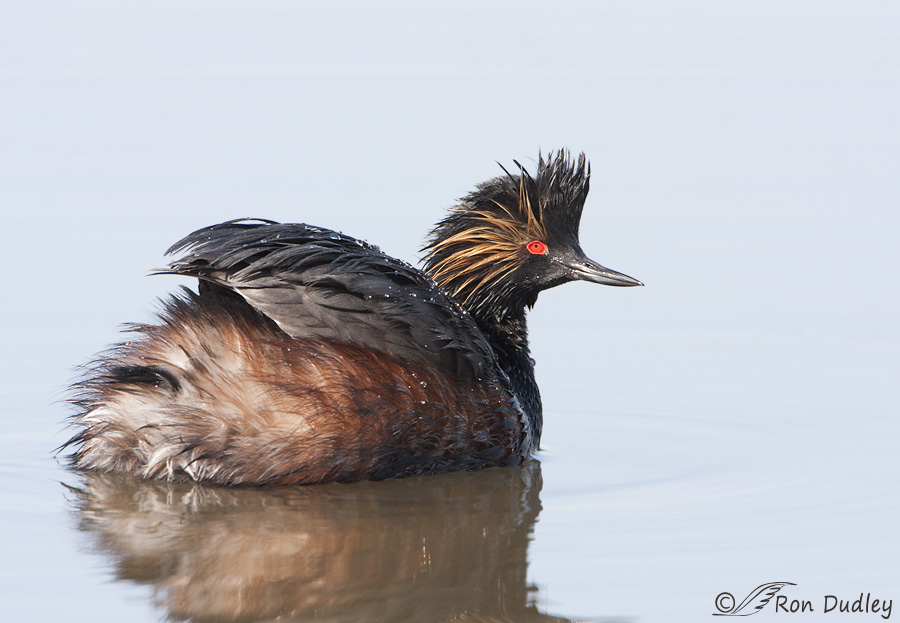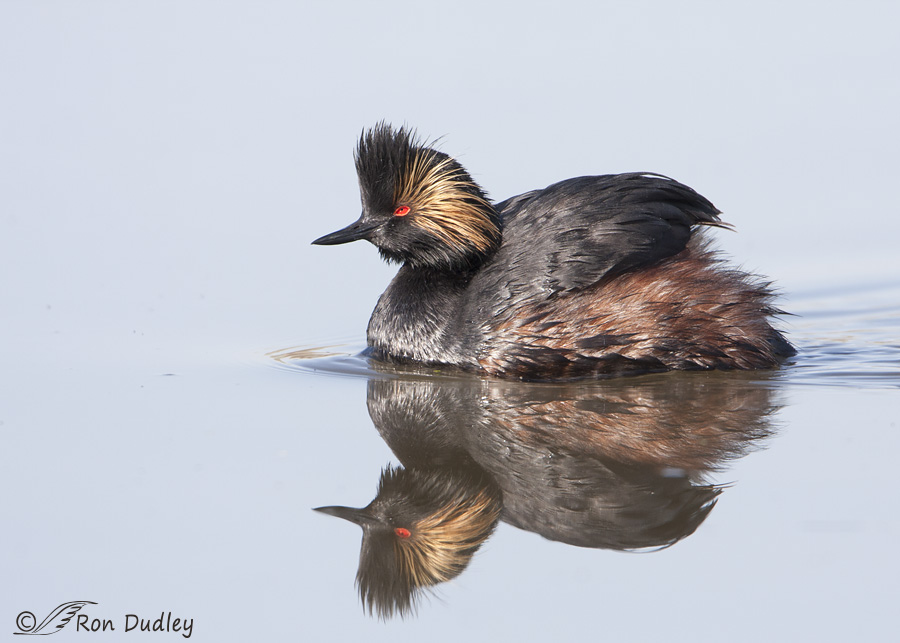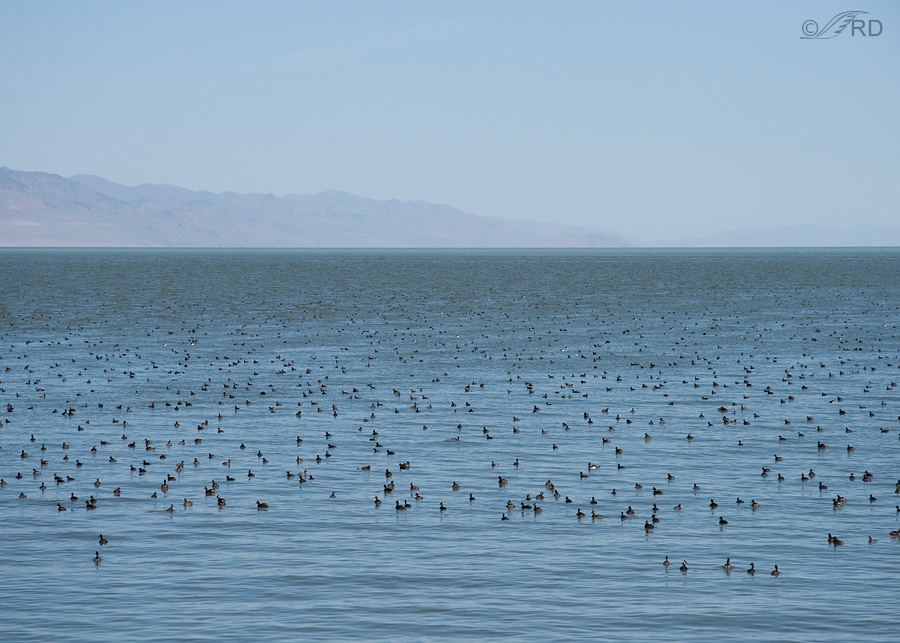The little Eared Grebe may be the most biologically interesting bird species I’m aware of.

1/500, f/8, ISO 500, Canon 40D, Canon EF 500mm f/4L IS USM + EF 1.4 II Extender, not baited, set up or called in
As common as they are in northern Utah during certain times of the year I’ve rarely been able to get close to them. The exception was a few years ago when I found several of them feeding on an insect hatch on Glover Pond near Farmington Bay. They were scurrying around on the pond as they snatched “bugs” off the surface and occasionally one would pause and look at me with an intensely scarlet eye.

1/800, f/7.1, ISO 500, Canon 40D, Canon EF 500mm f/4L IS USM + EF 1.4 II Extender, not baited, set up or called in
I actually preferred them a little further away so I could get their reflection in frame on the mirror-like surface of the water.

The Great Salt Lake is one of only two primary staging areas of Eared Grebes in North America (the other is Mono Lake, CA). This photo, taken in early May along the causeway to Antelope Island, shows mind-boggling numbers of grebes from the shoreline to roughly a half mile out into the lake. And there were just as many birds for much of the 7 mile length of the causeway. At times it’s estimated that there are 2.5 million Eared Grebes on the lake which is over half of the entire North American population
The physiological changes in body composition of Eared Grebes during their migration cycle are truly bizarre. Consider the following:
- When they arrive on the lake (a staging area before they continue migrating) in the fall they more than double their body weight from an average of 260 grams to more than 600 grams. They do this by adding huge fat stores and greatly increasing the mass of their digestive organs. At the same time their flight muscle mass shrinks by about 50% – to the point that they’re unable to fly. This muscle atrophy begins even before they molt their flight feathers.
- Then, before their migration south continues, they reverse the trend by fasting for 2-3 weeks which reduces their body mass to about 450 grams and they completely reorganize their body composition – digestive organ mass drops by two-thirds, leg muscles shrink, but pectoral (flight) muscle mass can more than double. When they gain flight back they migrate to their wintering areas.
- But it won’t be long before they have to prepare for their trip back north in the early spring so the cycle of atrophy/hypertrophy is repeated. This happens 3-6 times per year, whenever birds stop at one site for protracted periods of time. The premigratory increase of pectoral muscle and heart mass is required for migration while the premigratory decrease of digestive organs and leg muscle is considered a mechanism to reduce wing-loading and thus increase flight range in this poorly flying species.
- The overall result is that the Eared Grebe has the longest flightless period of any volant (flighted) bird in the world, perhaps totaling 9–10 months over the course of a year. At fall staging areas alone, flightless periods average 3–4 months for adults and may reach 8 months or more in nonbreeders.
The changes in size and proportion of Eared Grebe muscles and internal organs are the most extreme known in any bird species on earth and that matches their world record for flightless down-time.
All this makes me marvel at the incredible specialization of this most common grebe species in North America. But that specialization is also potentially an Achilles heel. They’ve become so dependent on the Great Salt Lake as a staging area it makes me fearful about what might happen to them as the lake dries up. Due to drought and mismanagement of water resources the lake now has only 29% of the surface area it had only a few years ago.
Food for thought…
Ron


Wild! Just read it to my 9 year old, and he agrees!
Powerful images and story Ron. The Great Salt Lake is so vital for so many species. The image of the huge number of Eared Grebes coupled with the back story sends a strong message of the Great Salt Lake’s importance. Now we just need the right people to listen to this and work harder to protect and even restore the migratory bird habitat.
Love the pic with the reflection. One of the lakes I would see these birds, Elizabeth Lake, did dry up. I keep praying for rain, but so far, it hasn’t been much.
As others have said, just fascinating! What an amazing bird, extraordinarily beautiful as well as biologically intricate and unique. Just WOW!
Gotta thank you for the string of OH WOW moments! What a great bundle of joy to look forward to each day! I just love learning new things!
“biologically intricate and unique” says it well about this species, Laura. Thank you.
You lucky guys in Salt Lake get to see the Eared Grebes in their breeding plumage. In coastal Calif. we mostly see them in their drab winter coats
We are lucky in that regard in the spring, John.
This is completely fascinating. Such a complicated adaptation. Such a precise adaptation…
And it sounds as if this is yet another species that our actions (teemed with climate issues – also possibly from us) have put in danger.
And a stunning looking bird as well.
I’m glad you found it interesting, EC. Thank you.
Absolutely fascinating information and gorgeous photography of these beautiful birds! I wish humans were able to turn fat into muscle this way — especially after the holiday season (which seems these days to run from “Little Candy Day” in October and ends with “Crap! I Forgot to Get my Wife a Box of Candy Day” in February).
There’s been a concerted grassroots effort to save Mono Lake for many, many years now. There has been some progress because the big water diversion down to LA had recently been stopped by the Coastal Commission, I believe, after a very contentious fight. Unfortunately, the drought hit shortly thereafter, but there had been at least some recovery. Hopefully, El Niño (which apparently missed the memo and pretty much bypassed SoCal) has brought enough moisture into Northern California to provide at least a little relief for these inland lakes. We’re fighting hard down here to save the remaining coastal wetlands in our area too.
Marty, It’s a never-ending fight with the developers and politicians and they’re the ones who win far, far too often. It’s very discouraging but we can’t just throw in the towel and give up. There’s too much at stake!
Very interesting information. I did not know all of that about the Eared Grebes, is it also true for the Pied Billed, Western and Clark’s?
Have you attended any of the meetings on the Bear River Project? I attended one but left in disgust. It left a nasty taste in my mouth almost as bad as the Crow hunt meetings. In my opinion they ask for public input but the powers to be have already made up their minds and are having the public meeting to fulfill legal obligations.
On a happier note, I thought you would be out on an adventure this morning with the blue sky and beautiful sunrise this morning. I was sorely tempted but between the temperature and having too much to accomplish before Christmas I opted out. We have school up to the 23rd this year.
April, No, I don’t believe it applies to the other grebes – at least not to this extent.
I’ve attended none of the Bear River meetings for exactly the reason you mention. That crow hunt meeting with the Wildlife Board left me thoroughly disgusted with the process. You’re right – in situations like these their minds are already made up.
I have a commitment at home that’s keeping me reigned in today, though I have made a couple of quick and fruitless visits to a local pond…
Sometimes I’ve found that I need to hold my nose and go to these meetings (and school board meetings), as disgusting as they are. And bring as many friends as I can. And have a bunch of us speak during the comments time. It doesn’t always change things right away, but occasionally there’s a news crew (gosh, how did that happen?) or at least the meetings are televised and the word gets out. It’s exhausting and demoralizing, but every once in a while our side can eke out a small, yet significant, victory. My name is Quixote. Don Quixote. 😉
🙂
Reading your blog and the morning news is my ritual, along with my coffee and toast; The photos are gorgeous of course, and the stories and information are enriching. I want you to know that your time, effort and knowledge are deeply appreciated. Such an informative, interesting post Mr Dudley! <3
I appreciate the kind words, Susan. Thank you.
29%!!!!!
Yup, since 1988.
Great shots and fascinating information! Those bright red eyes are very intense.
It looks like a whole lot of the west is in a drought, and as of 4 years into our drought Mono Lake had shrunk five feet. I can’t find anything for how much it’s shrunk by now, but I’ll bet it’s bad.
In matters we can’t change, like drought, we can only hope for a good outcome.
Levi, Human mismanagement of water resources is at least as responsible for the decline of the GSL as the drought. And the greedy shortsighted politicians have proposed putting in several more dams on the Bear River – one of the primary water sources of the lake.
Very few politicians have in mind the welfare of the environment and the many people who depend on and/or love it when they make their money-motivated decisions.
Beautiful portraits of a bird I’ve never seen. I can’t wrap my mind around their physiological changes. It seems bizarre, even though there is probably very good reason for them. And hopefully the Great Salt Lake will not continue to shrink (probably wishful thinking…).
Thanks, Susan.
Fascinating, Ron, I had no idea about this little guy having such bizarre biology. I wish we could take better care of their staging areas.., merry Christmas to you and your family!
Thank you, Christina, and the same to you!
Fascinating information. Do you know what triggers the changes? Hormones? Sunlight, temperature? Many birds’ reproductive organs change with the breeding season, enlarging and becoming active, and then shrink when the young of the year are fledged. And I’ve read that hormonal changes are triggered by increasing a number of things. Of course something triggers the molt as well. Food for thought and more research for me!
No, I don’t know, Sallie. As you say it must be hormones but I’ve never read anything about what triggers the change.
Well, Ron – we are not alone: Here, from BNA Online: ” The significance of obesity in adult grebes in fall remains a puzzle, as does the endocrine mechanism promoting rapid hypertrophy of flight muscle. Further studies of changes in body composition, to include juveniles, would be valuable.”
Thanks, Sallie! I got much of my info at BNA too but I missed that little gem.
If BNA doesn’t know I suspect no one does!
So cool to see all those grebes!
Like the Great Salt Lake, Mono Lake in California has been badly affected by drought and its water level has decreased over the past few years. This raises the salinity and mineral concentration of the water which results in declining brine shrimp population, as happened in the 1980s when Mono Lake faced ecological collapse. Back then, the cause was LA Water & Power removing the lake’s incoming freshwater sources, but now it’s drought (resulting from global climate change?). These grebes indeed face a tenuous future. Getting back to their biology, it’s also interesting to consider the physiology that allows them to switch from freshwater breeding areas to salt water wintering areas.
They’re interesting birds all-round, Marie.
I was unfamiliar with the ecological issues at Mono Lake you mentioned. Thanks very much for telling us about them.
Hi Ron,
Thanks for the biology lesson and love the photos.
Its disturbing about the surface area of Salt Lake. It would be nice to hope for some recovery over time. As you probably know, Southern California has its own prospect of loosing inland water body that potentially could be a major environmental issue as well as loss of habitat, the Salton Sea. Apparently discussions continue about remediation, however little if anything is getting done as I understand it. My wife and I love to head down to Borrego Springs in the winter to take in the warmer weather and have spent quite a bit of time over at the Salton Sea photographing birds. If nothing is down to replenish this artificial body of water, not only will we loose the habitat for the birds, but watch out for a significant degradation of air quality. This to supply a little more water to San Diego. Don’t you just love the management of water resources in the west!
Have a great day, Frank
Frank, I’ve read some things about the management issues with the Salton Sea. The history of that lake is incredibly interesting – this from Wiki:
“The most recent inflow of water from the now heavily controlled Colorado River was accidentally created by the engineers of the California Development Company in 1905. In an effort to increase water flow into the area for farming, irrigation canals were dug from the Colorado River into the valley. Due to fears of silt buildup, a cut was made in the bank of the Colorado River to further increase the water flow. The resulting outflow overwhelmed the engineered canal, and the river flowed into the Salton Basin for two years, filling the historic dry lake bed and creating the modern sea, before repairs were completed”.
And the air quality issues you mention are similar to the ones we face with the decline of the Great Salt Lake. All those square miles of dry lake bed will produce incredibly dusty conditions in much of northern Utah whenever the wind blows.
Beautiful birds, Ron! 🙂 Fascinating biology – no end to the adaptations mother nature provides her creatures. The Great Salt Lake decreasing in size certainly could be a major stumbling block for them – hope it doesn’t happen and/or they find another staging area! They must be pretty vulnerable to predators during that time.
“hope it doesn’t happen and/or they find another staging area”
I’m afraid that’s unlikely, Judy. They need highly saline lakes to provide their staple diet of brine flies and brine shrimp. Mono Lake and the Great Salt Lake are about their only large alternatives (that I’m aware of).
WOW! I love these photos! Sad about how many changes are happening to habitats for birds and animals.
Yes, it sure is, Jerilyn. Thank you.